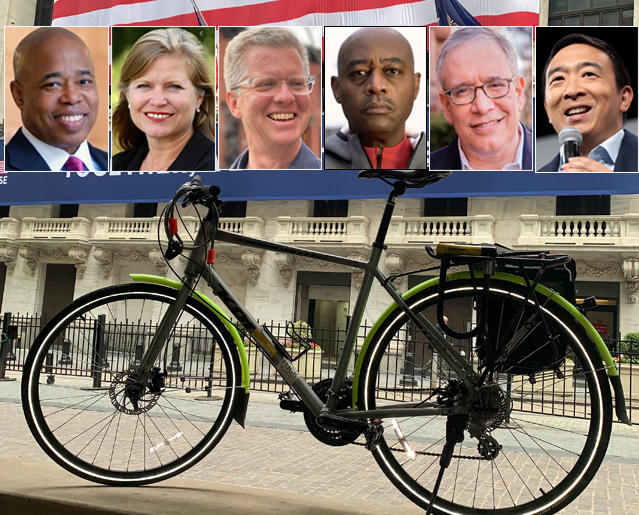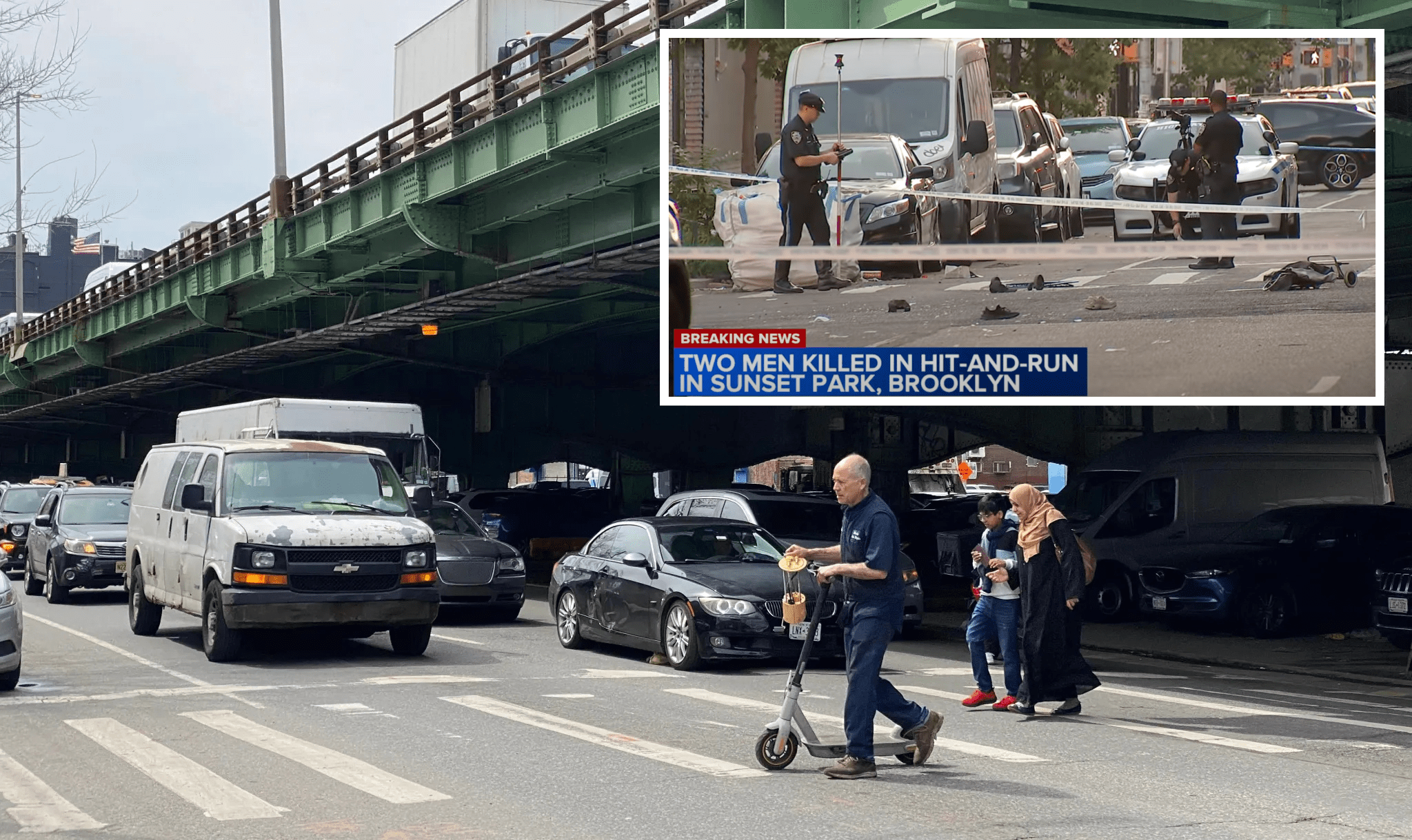Will the next mayor's big bike plans still work when they get punched in the face?
At Monday night's bike-focused mayoral forum, every candidate told moderator and Bike New York Director of Advocacy and Communications Jon Orcutt that he or she had big plans for turning New York City into a real bike-friendly place.
But how can such an ambition be achieved? That's where the answers left some veterans of city cycling politics hoping for more. Let's take a look.
Listening to the @bikenewyork mayoral forum. Free advice to all candidates: Don't promise to double NYC's protected bike lanes and tell us the same old community board veto process will get us there. We know that won't work!
— Seth Pollack (@sethmpk) March 2, 2021
Expansion efforts
Brooklyn Borough President Eric Adams appeared to be the only one who wanted to look past traditional community board involvement in the bike lane process. Adams spoke about smaller conversations led by "credible messengers," who can ease a community's concerns before opposition gets locked in.
"Here's the problem we're having now: people, rightfully or wrongfully, connect bike lanes with gentrification," said Adams. "People believe they're an indicator they'll be displaced and it's not something that's part of the overall build-out of their community. Let's change that dialogue. We need to bring in the credible messengers of these communities and engage them in the benefits of safe biking. Have clergy rides, have rides with BIDs and civic groups. The real change comes from the ground up."
Adams's comments fit the mold of Transportation Alternatives's "NYC 25x25" plan, which seeks to go beyond community boards as gatekeepers and expand the range of voices who get to weigh in on streetscape changes. But Adams also relied on a trope that community boards seem to lean on whenever they don't get the street designs they want: "No one listens to us."
"I've communicated with community board members around the borough, and I'm telling you that at the heart of their concerns, they feel, 'Eric, no one is talking to us they're talking at us.'"
Meet the mayor
Comptroller Scott Stringer gets a medal for bravery for his answer, but the reality of his answer fits awkwardly with his ambitious plans.
"I will commit to this: As mayor I'll go to community boards, I'll build consensus around the table," Stringer said.
It's very funny to picture the mayor going to Brooklyn Community Board 10, where DOT reps have said they fear being tarred and feathered for removing parking spaces, to pitch something more than the paint on the ground. But Stringer may have a lifetime of working with community boards, but advocates point out that the process still would be stuck in the old ways even if the mayor is willing to get in there himself.
"I’d love to think someone could come along with the kind of talent it would take to get everyone on the same page about a new bike lane, but that would be a skill more akin to magic than politics," said Doug Gordon. "We need the next mayor to redefine and streamline community engagement."
Besides, it's not like Mayor de Blasio hasn't put in some face time and taken questions on bike lanes during community forums. And look how well that worked out for the still-unfinished final leg of the Queens Boulevard bike lane.
Consultancy firms
The closest anyone came to telling community boards they might have to kick rocks was former Sanitation Commissioner Kathryn Garcia, who said that she sees a role for community boards to advise on a process, but not much beyond that. Garcia said that she would approach New Yorkers, and community boards, with a total vision of her bike network to allow them to see their place in it. Seeing that, Garcia suggested, would spur support, especially in a world where the open streets and open restaurants programs happened and didn't destroy the city.
The former trash chief said that she wanted to allow community boards to keep a consultation role around bike lanes, but seemed to suggest they wouldn't be able to opt out of Mayor Garcia's citywide bike network.
"It'd be like if you couldn't ride the subway between the Seventh Avenue stop and the Fort Hamilton stop on the F train," said Garcia. "That sort of strands everybody at the end of the line. So you need to ensure people think of bike lanes in the same way they think of the subway, as a network of connectivity."
On the other hand, learned New Yorkers suggested that some community boards would choose parking over subway entrances if given the choice.
i truly believe that if we let community boards choose between keeping the subway entrances in their neighborhood or adding an extra parking space on the sidewalk, we would lose access to the subway in like a week
— nevona (@nevona) March 1, 2021
Combo meal
Former Bloomberg and Obama official Shaun Donovan said that his big plan to win over community boards would be to present his streetscape changes as a combo meal, because who doesn't love getting sides included with a main course?
"If we're introducing this as a comprehensive set of options, where say you're going to get a bus system that gets to job centers in 15 or 20 minutes instead of an hour, if we truly are aligning the signaling with the buses, and in those transformations are also adding bike lanes and other options, we're bringing Citi Bike, I think you start to change that conversation, not just with what you're taking away in terms of cars but what you're adding in terms of cars," said Donovan. "And that I think can start to change the conversation."
It's an interesting proposal, and one that gets at what de Blasio said when he introduced the Green Wave, that people needed better mass transit options along with safe bike routes in order to embrace getting out of cars. On the other hand, the city tried this when it included bike lanes in the 14th Street Busway proposal — and, if anything, that combo only made the opposition angrier. If it doesn't work well in Manhattan, how would a combo meal taking more parking and travel lanes work somewhere like Main Street, where "BLM" stands for "Business Lives Matter," according to City Council Member Peter Koo.
Who's running the show
Ray McGuire, the banking executive whose legendary silence towards Streetsblog left us without a clear picture of where he stood on safe streets, showed up to the forum with a background bike and a proclamation that he was in "all-in" on bikes.
Ray McGuire has added a bike to his fancy Zoom background pic.twitter.com/BsoL3tGArD
— Good Idea Dave (@DaveCoIon) March 2, 2021
However, McGuire's excitement was tempered with the belief that the city been big-footing neighborhoods and not allowing them to have control of the streets. McGuire said he'd lay out a vision for a connected bike network, but the commitment to building it relied on getting permission.
"What we haven't done with major projects like this before is involve the people who are going to be most impacted," said McGuire, using an odd term — major projects — to describe bike lanes. "We prescribe, but we haven't included. In my leadership, we would get the right leaders in the communities and if we have to go down by neighborhood, then we'll do that, because that's where people's lives will be most impacted."
McGuire seems animated by bikelash talking points about the heavy hand of the DOT, but in a world where the agency holds visioning sessions and promises yearlong outreach efforts for a bike network in East Flatbush that doesn't even guarantee protected bike lanes, who is best-served by an insistence that the city is moving too fast? Besides, polling shows that New Yorkers want safe streets, so why shy away from a big push?
What?
Current frontrunner Andrew Yang didn't so much dodge the question as much as he tripped over it like Dick Van Dyke meeting an ottoman. His answer, in full. before pivoting to why he wanted control of the MTA:
I've had some of those conversations, quite recently. When I talk to folks about bike lanes in certain parts of the city, there is some resistance. One of the things they say is 'If it makes it hard for me to drive a car, I'm not into it.' But they also say 'If it's gonna cost me money I'm not into it.' Those are the two main objections. One of the things I respond with is, it's hard for someone to see it as a possibility if something isn't there yet. So one thing I'd like to see is a bike lane on the Verrazzano Bridge.
So anyway, there's your frontrunner.






